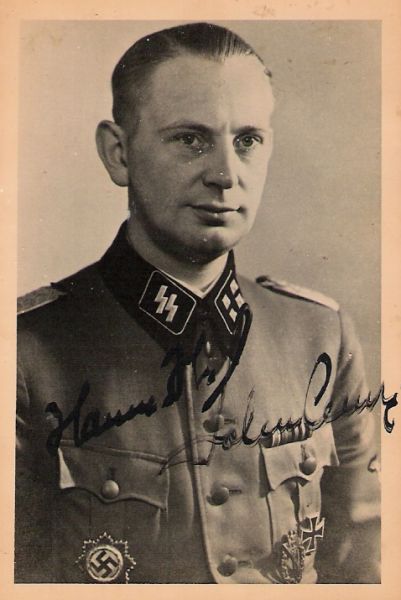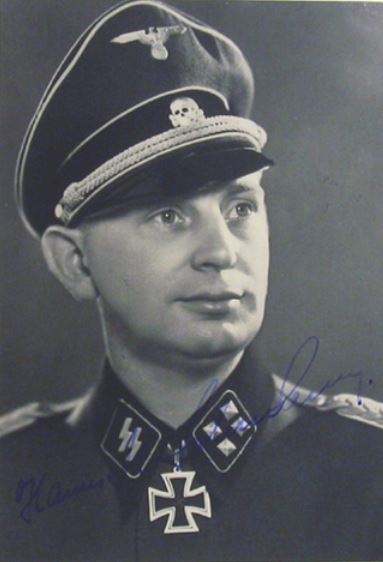Lohmann, Hans-Heinrich 'Hanns' (Waffen SS)
- Date of birth:
- April 24th, 1911 (Gütersloh/Westphalia, Germany)
- Date of death:
- May 25th, 1995 (Gütersloh/Northrhine-Westphalia, Germany)
- Service number:
- SS-Nr.: 29.097 // NSDAP-Nr.: 218.303
- Nationality:
- German
Biography
Promotions:
20.04.1934: SS-Untersturmführer
01.04.1936: SS-Obersturmführer
09.11.1938: SS-Hauptsturmführer
30.01.1943: SS-Sturmbannführer
30.01.1945: SS-Obersturmbannführer
Career:
00.11.1929: SA-Mann - entered the NSDAP
01.02.1932: joined the SS
20.04.1934: promoted to SS-Untersturmführer
00.01.1935: SS-Ustuf, Zugführer, IV. Sturmbann, SS-Standarte 'Deutschland'
00.11.1935: severely wounded to the left ankle in a sporting accident
01.04.1936: promoted to SS-Obersturmführer, Aufsichtsführer und Adjutant, Stab, SS-Junkerschule Bad Tölz
00.01.1937: SS-Ostuf, Kompanieführerlehrgang, 3. Friedens-Junker-Lehrgang, SS-Junkerschule Bad Tölz
09.11.1938: promoted to SS-Hauptsturmführer, SS-Standarte 'Deutschland', SS-VT
00.07.1939-00.08.1939: SS-Hstuf, Ausbildungsleiter, SS-Junkerschule Bad Tölz
00.00.1939-00.00.1940: SS-Hstuf, Stab, Oberkommando des Heeres
00.11.1939: SS-Hstuf, Chef, 2. Batterie, SS-Artillerie-Regiment 3, SS-Division 'Totenkopf'
00.06.1941: SS-Hstuf, Führer, 2. Kompanie, I. Bataillon, SS-Infanterie-Regiment 'Westland', SS-Division (mot) 'Wiking' - campaign in Russia
00.04.1942: SS-Hstuf, Führer, 2. Kompanie, SS-Panzergrenadier-Regiment 10 'Westland', 5. SS-Panzer-Division 'Wiking' - evacuated for Malaria
00.10.1942: SS-Hstuf, Kdr, I. Bataillon, SS-Panzergrenadier-Regiment "Nordland", SS-Panzergrenadier-Division "Wiking" - Caucasus, Kotenikovo and Simovniki region
31.12.1942: Operation 'Edelweiss' - Caucasus
30.01.1943: promoted to SS-Sturmbannführer
00.05.1943: SS-Stubaf, Kdr, III. Bataillon, SS-Panzergrenadier-Regiment 23 "Norge", 11. SS-Freiwilligen-Panzergrenadier-Division 'Nordland' - Truppenübungsplatz Grafenwöhr
00.07.1943: campaign in Italy then Croatia
00.08.1943: SS-Stubaf, Schnelle-Truppenführer-Lehrgang, Paris
00.09.1943: campaign in Russia, Oranienbaum - Leningrad - Narva
00.02.1944: SS-Stubaf, Führer, SS-Kampfgruppe
02.02.1944: SS-Stubaf, WIA and sent to a Lazarett
00.04.1944: SS-Stubaf, Regiments-Führer-Lehrgang, SS-Junkerschule Bad Tölz
00.08.1944: SS-Stubaf, Führer, SS-Wachbataillon, Leibstandarte SS Adolf Hitler, Berlin
27.10.1944: SS-Stubaf, Kdr, SS-Panzergrenadier-Regiment 49 'De Ruyter', 23rd SS-Freiwilligen-Panzergrenadier-Division 'Nederland', III. SS-Panzer-Korps - Kurland
30.01.1945: promoted to SS-Obersturmbannführer
00.02.1945: SS-Ostubaf, Kdr, SS-Panzergrenadier-Regiment 23 'Norge', 11. SS-Freiwilligen-Panzergrenadier-Division 'Nordland' - Gollnow region
Do you have more information about this person? Inform us!
- Period:
- Second World War (1939-1945)
- Awarded on:
- July 13th, 1941
- Period:
- Second World War (1939-1945)
- Awarded on:
- September 14th, 1941
- Period:
- Second World War (1939-1945)
- Awarded on:
- April 20th, 1942
- Period:
- Second World War (1939-1945)
- Awarded on:
- August 1942
- Period:
- Second World War (1939-1945)
- Rank:
- SS-Hauptsturmführer (Captain)
- Unit:
- Führer, I. Bataillon, SS-Infanterie-Regiment 'Nordland', 5. SS-Panzergrenadier-Division "Wiking", Waffen-SS
- Awarded on:
- March 11th, 1943
Name is written in Patzwall / Scherzer as Hanns.
- Period:
- Second World War (1939-1945)
- Awarded on:
- February 1944
- Period:
- Second World War (1939-1945)
- Rank:
- SS-Sturmbannführer (Major)
- Unit:
- Kommandeur, III. Bataillon, SS-Panzergrenadier-Regiment 23 'Norge', 11. SS-Freiwilligen-Panzergrenadier-Division "Nordland“, Waffen-SS
- Awarded on:
- March 12th, 1944
“On the 31.01.1944 the III./SS-Pz.Gren.Rgt. ‘Norge’, under the command of SS-Sturmbannführer Lohmann, was in positions in the Luga bridgehead along the eastern edge of Jamburg. The ordered withdrawal from the bridgehead took place on the following night after a hard yet successful defensive battle by friendly forces.
Following the evacuation of the bridgehead SS-Sturmbannführer Lohmann would have the mission of occupying new defensive positions on the west bank of the Luga. By inserting his Bataillon between von Kramer’s Bataillon and Kampfgruppe Vogt he would greatly strengthen the defensive line that hitherto was only being held thinly by combat group Stoffers.
At the start of Lohmann’s withdrawal movement from the bridgehead the following situation had taken shape at the southern part of the west bank:
- During the whole day the enemy was transferring strong forces to the west bank of the Luga, south of Saretschje. Several flank attacks against the II. Bataillon, in positions at the paper mill and Saretschje, were repulsed successfully (partially with counterthrusts) by the Bataillon. However a further reinforcement of the enemy meant that in the evening hours of the 31.01.1944 it was necessary to withdraw the II. Bataillon to a blocking position between the Luga and the Pjatnitzkij swamp (see sketch) -
At around 04:30 on the 01.02.1944 Lohmann and his Bataillon were still in the process of withdrawing. The 9. & heavy Kompanien were at the eastern edge of Nowo Pjatnitzkoje, and the 10. & 11. Kompanien were in the western part of Jamburg. Having heard that the enemy had pushed far to the west with overwhelming forces, overrun the blocking positions of II. Bataillon and now had lead elements that were already 300 metres south of the road, Sturmbannführer Lohmann immediately dispatched his Bataillon for a counterthrust on his own initiative. They would pass through the parts of II. Bataillon that had pulled back and engage the enemy.
III. Bataillon conducted a surprisingly swift deployment, with 9. Kompanie advancing past Hill 25.2 towards the southeast and 10./11. Kompanien moving out to the south (see sketch). In a hard nocturnal close-combat engagement, in which Sturmbannführer Lohmann distinguished himself through outstanding personal bravery, the enemy was thrown back with extremely heavy losses. This continued until the old positions were again under friendly control.
It was only thanks to the outstanding personal bravery of Sturmbannführer Lohmann, a man who inspired his troops at a decisive moment of the hard close combat through his own example, that this counterthrust met with success.
The tremendous energy and independent decisiveness of the commander of the III./SS-Pz.Gren.Rgt. ‘Norge’ ensured that the enemy attempt to cut off our troops still in the bridgehead and on the west bank was prevented. Furthermore the enemy lost a great deal of both light and heavy infantry weapons, as well as a large part of their assault forces. Due to this the subsequent planned withdrawal of the Division to Dubrowka could be conducted according to plan and with minimal friendly losses.”
- Period:
- Second World War (1939-1945)
- Rank:
- SS-Obersturmbannführer (Lieutenant-colonel)
- Unit:
- Führer, SS-Freiwilligen-Panzergrenadier-Regiment 49 'De Ruyter', 23.SS-Freiwilligen-Panzergrenadier-Division "Nederland" (niederl. Nr.1), Waffen-SS
- Awarded on:
- May 9th, 1945
On the 23.01.1945 the Soviets managed to achieve a penetration at the boundary between Lohmann’s regiment and the 30. Infanterie-Division. However, despite the loss of all radio and telephone communications, it was possible to prevent a further enemy advance through a determined strongpoint-like defensive network.
The next day the Soviets tried to encircle German forces located south of Purmasati from the north and south with 10 tanks and 200 men. Lohmann’s regimental command post was encircled in Kaleti by enemy tanks, but the Germans defended it bitterly with Lohmann in the foremost line. His resistance here ensured that the already encircled/bypassed friendly strongpoints could also be held onto. The day after this, the 25.01.1945, the Germans succeeded in pulling back their frontline to the preprepared Krimhild line.
Lohmann would be awarded the Oakleaves for his achievements during this time period.
The recommendation was made on February 26th, 1945 and arrived at the OKH/PA/P5 on April 23rd, 1945. The recommendation was supported by Generalleutnant, Kommandierender General III.(germanisches) SS-Panzerkorps on March 19th, 1945, without comments of OB 11.Armee, HGr Weichsel and Reichsführer SS ; official HPA proposal (HPA-VV) prepared without Nr. ; Karteikarte existing ; both without further handling or hints to an award. Definitive confirmation of awarding is not known. Case treated by OdR Ordenskommission in 1974 and decided : "ja 872.EL" ; award accepted by OdR in accordance with so-called "Dönitz-Erlass"; 872nd award and award date determined by OdR.
Sources
- Photo 1: Dobri Dobrev
- Photo 2:
- - FELLGIEBEL, W.P., Elite of theThird Reich, Helion & Company Limited, Solihull, 2003.
- MOONEY, PETER, Waffen-SS Knights and their Battles, Schiffer Military History, 2016.
- PATZWALL, K. & SCHERZER, V., Das Deutsche Kreuz 1941-1945, Band II, Verlag Klaus D. Patzwall, Norderstedt, 2001.
- THOMAS, FRANZ & WEGMANN, GüNTER, Die Eichenlaubträger 1940-1945, Biblio-Verlag, 1998.
- das-ritterkreuz.de
- Awardholders / unit
- Microfilm Publication A3343. US National Archives. - Lohmann Hans-Heinrich





















